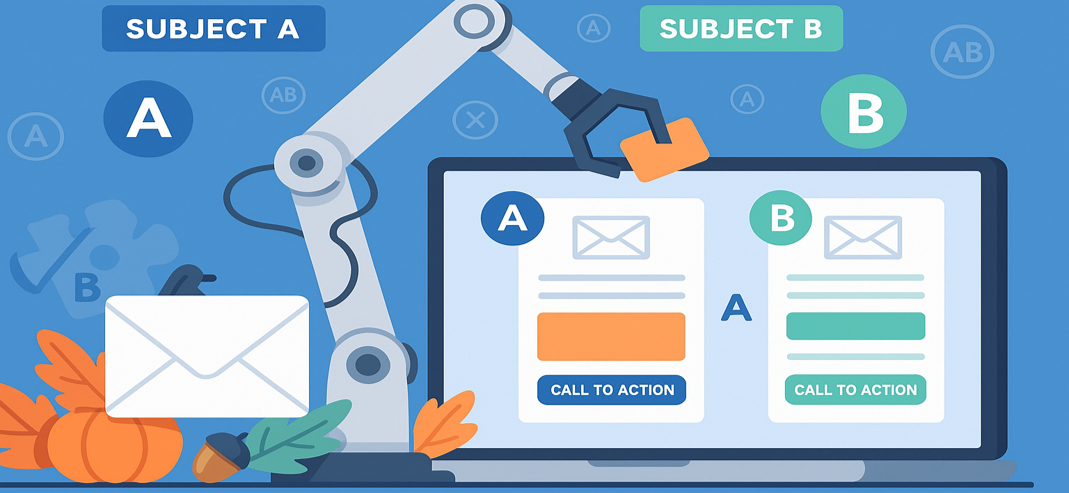- Home
- Science-Backed Marketing Insights
- How to Use AI for A/B Testing ...

Is email marketing old-fashioned? It might look like this to some folks, but email marketing still is one of the most effective channels for building relationships and driving revenue for online businesses. And AI is entering the stage. According to the HubSpot blog, 55% of AI-using marketers rely on it for text-based content creation. Additionally, 38% use it for creating multimedia, like images or video. AI can also be very helpful when you want to analyze a customer response to email campaigns.
Well, you might know from your own experience that success often comes down to a single factor: optimization. There are plenty of tools in digital marketing to choose from, just like clubs in golf. And A/B testing is definitely one of them. It has long been the gold standard for improving subject lines, calls to action (CTAs), and personalization strategies.
You may argue by saying that traditional A/B testing has its limitations. Yes, this is true, because A/B testing’s well-known drawbacks are slow learning curves, the need for large sample sizes, and sometimes inconclusive results. AI-powered A/B testing comes in to change things. AI can help you mix a nice digital marketing blend, as it can automate, accelerate, and personalize testing and go even further. For example, with AI involved, you can figure out the likelihood of conversion, which is one of the essential parameters in email marketing.
According to Salesforce, a marketer from Resilient Innovation, a U.S.-based marketing agency, had his A/B testing in email marketing improved 10x using generative AI. He didn’t only test subject lines but went further to test user behavior, which allowed him to be more strategic with every send.
In this guide, we’ll explore how AI fundamentally transforms A/B testing. We will walk you through a practical, step-by-step process to implement AI-driven optimization in your campaigns. So, let’s find out…
Why A/B Testing Is Critical in Email Marketing
So why is it essential? Simply because A/B testing allows you to make well-crafted, data-driven decisions. You don’t have to rely anymore on guesswork and black magic. Let’s look at the benefits:
- Subject lines: You can test different phrasing, emojis, or personalization tokens to maximize open rates.
- CTAs: Play with placement, wording, or design to increase click-through rate. A great call-to-action solution can be a game-changer in your email marketing campaign.
- Personalization: You should try various A/B testing personalization options to understand how tailored content impacts engagement and conversions.
If you implement it properly, A/B testing will chart your roadmap to a successful email campaign. By the way, for an overview of best practices, check out Sendigram’s guide to A/B testing mistakes.
Traditional vs. AI A/B Testing
Let’s now learn why automated email testing with AI can take you to the next level.
The problem with traditional testing
- First, it requires large sample sizes to achieve statistical significance, so you must allocate more resources.
- Second, results can be rather slow to accumulate, so you have to wait until the test finishes before making changes.
- Finally, traditional A/B testing offers winner-takes-all models. Such an approach often ignores real-time opportunities for optimization.
How AI accelerates learning
Let’s discover how AI-powered testing will help you overcome traditional A/B testing obstacles. See what it is capable of:
- AI analyzes smaller datasets with predictive algorithms. This would save you time and money.
- AI learns during the campaign permanently. In this case, there is no need to stop and declare a winner.
- AI identifies subtle patterns across subscriber segments that we, humans, might miss.
Are you impressed and looking for a deeper context? Check out this article on multivariate vs. A/B testing.
The Role of AI in Email Marketing Optimization
The cool thing about AI is that, instead of running one test at a time, it offers adaptive, real-time testing. Let’s check out its features:
- Dynamic AI subject line optimization: Algorithms decide which subject line variant to serve each subscriber based on past behavior.
- Send time prediction: AI determines when the customer is most likely to engage. No guesswork, just a scientific approach that is changing email marketing forever.
- Content personalization: Different strokes for different folks. In the case of AI-powered A/B testing, this is how it works: different audience segments receive different images, offers, or CTAs. And all are tested automatically.
To make a long story short, AI shifts email testing from old-fashioned, static ways to a future with ongoing optimization engines.
Step-by-Step Guide to Implementing AI in Email A/B Testing
Let’s look at the seven steps that we offer in our guide:
Step 1: Define email campaign goals and metrics
Before dealing with AI, make it all clear. You must decide whether your campaign optimizes for:
- Open rates. This metric is a perfect option for subject line testing.
- Click-through rates. CTRs are great for defining which call-to-action solution works better. It is also helpful if you want to test design options.
- Conversions. You can use this metric for e-commerce and SaaS.
👉 Our tip: avoid vanity metrics. For instance, open rates alone don’t really matter if clicks and purchases don’t follow. Let metrics work together!

Step 2: Prepare and segment your data
It is not rocket science: AI works best with clean, structured data. To achieve it, you must do the following:
- Remove inactive subscribers and bounced addresses.
- Collect engagement history like open/click logs and purchase activity.
- Segment audiences by behavior, demographics, or customer lifecycle stage.
If you feel like wanting to know more about data segmentation, look for this Sendigram article on personalization in A/B testing.
Step 3: Use AI to generate and select test variants
AI can also make your life easier. Forget about manually drafting subject lines or CTAs. Now you can use AI copy generators to develop dozens of fantastic variants in seconds.
Let’s look at what can be done:
- AI-driven subject line testing. For example, you can compare “John, this is your last chance!” vs. “John, hurry up! Your exclusive deal ends tonight.”
- Dynamic preview text. It can be tailored for urgency or curiosity. Dynamic elements are a great tool if you want to catch people’s attention.
- Content blocks. Here, we talk about things like product recommendations and banners that can be matched to segment profiles.
AI also uses predictive targeting to serve different versions to different audiences. Again, no guesswork!
Step 4: Optimize campaign execution with AI algorithms
Here’s where AI truly shines:
- Multi-armed bandits. It is not just a funny definition. Such algorithms dynamically reallocate traffic to the best-performing variant. You don’t have to wait anymore until the test ends, saving you time. And time is money!
- Bayesian modeling. It predicts outcomes with smaller sample sizes, reducing wasted impressions. It is all about more optimization.
- Send time optimization. This feature predicts when each subscriber is most likely to open, boosting engagement without extra content. Very useful knowledge!
Step 5: Automate insights and reporting
AI is capable of transforming raw numbers into something that is known as actionable intelligence. This includes:
- Real-time dashboards. AI lets you track which words, colors, or layouts resonate best with each segment.
- Natural language summaries. You will be receiving instant “executive briefs” on campaign results without deep data crunching.
Want to dive deeper into testing tools? Check out Sendigram’s list of A/B testing software.
Step 6: Deploy, validate, and scale
Using AI-powered subject line testing vs. traditional methods is a good start. Then, you can expand gradually:
- First, compare results to benchmark performance.
- Then, scale AI testing to CTAs, visuals, product recommendations, and email design.
👉 Did to know? Case studies consistently show that AI-driven A/B testing delivers faster learnings and higher ROI?
Step 7: Ensure responsible use of AI in email marketing
AI is a mighty tool, isn’t it? However, you shouldn’t overvalue it. AI must enhance—not replace—your brand voice and relationship with subscribers. Just keep in mind three simple rules:
Rule #1: Avoid overpersonalization that feels intrusive or even aggressive. Don’t mention John’s or Mary’s names in every sentence. Also, don’t litter with other personal data. You are a digital marketing pro, not Big Brother!
Rule #2: Respect privacy and consent, particularly with sensitive data. This is something that may have legal consequences, as the law strictly protects privacy.
Rule #3: Keep your human oversight to preserve brand authenticity. While AI is an excellent creator and developer, your finishing touch can ensure the best results.
Here’s our idea for your inspiration regarding ethical optimization: just read Sendigram’s best practices for email design testing.
To Sum Up
No worries: the future is bright because AI is not here to replace you. It has come to empower you. According to Hawke Media digital marketing agency, in the years to come, AI in A/B testing will likely evolve in three directions. These are:
- Predictive A/B testing.
- Hyper-personalized testing.
- Automated creative generation.
With our seven-step guide, you will move from static split tests to dynamic, AI-driven optimization, achieving three wonderful things in email marketing:
- Saving time—and money!
- Getting insights faster.
- Providing more relevant experiences to subscribers.
Dream big but start small! While using AI, you have to validate results and scale responsibly. Thanks to AI-powered A/B testing, email marketing becomes less of a guessing game and more of a continuous, data-driven growth perpetuum mobile. AI can dramatically optimize your email marketing campaigns, so our last advice would be: grab it to drive your sales!




